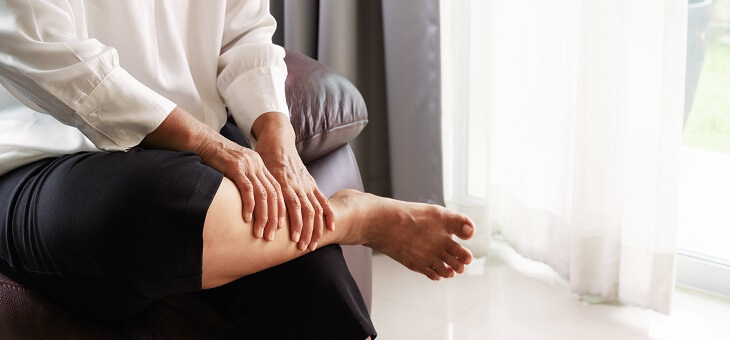Muscle cramps are painful contractions of a muscle or part of it. They usually occur in the calf muscles, although they can affect any part of your leg, including your feet and thighs.
It feels as though your muscle has clenched and tightened into a knot and you can’t control it or get it to release. In most cases, the cramp lasts for a few seconds to a few minutes before spontaneously resolving. But you may have pain and tenderness in your leg for several hours after the cramping has passed.
Most Australians have experienced a cramped muscle at least once in their life. However, for some people, they occur frequently and can interrupt exercise and daily activities, sleep and general quality of life.
Frequent leg cramps, especially while exercising, are mainly caused by a medical condition diagnosed as peripheral arterial disease (PAD), commonly called poor circulation, which affects one in five Australians in some way.
“Muscle cramps are often described as an intense muscle pain or painful tightening of the muscles, which happens suddenly and uncontrollably, usually in the legs,” says Dr Martha Mackay, scientific officer at Actegy Health. “They can be caused by many things from dehydration, overusing or straining a muscle, pregnancy, poor circulation or due to certain medications.”
For 61-year-old Patti Bee, cramps were affecting her ability to sleep properly. “I was being woken by violent calf cramps at night, which was preventing me from getting a good night’s sleep. Tiredness was then impacting my quality of life and my ability to take care of my husband who has medical issues and is legally blind. I tried taking magnesium, but it only helped a little bit,” says Ms Bee.
Read: Signs you may have a magnesium deficiency
How to reduce the risk of leg cramps
While gentle flexing and stretching of the muscles before and after exercise may help soothe occasional leg cramps, frequent leg cramps can be more serious, so it’s important to seek medical advice to find out what might be causing them.
“Inactivity, a sedentary lifestyle, smoking, living with diabetes, high blood pressure or high cholesterol are risk factors for poor circulation associated with peripheral arterial disease. People with these risk factors are advised to consult their doctor to understand more about PAD and how to help prevent or manage their condition,” says Dr Mackay.
Here are eight things you can try that may reduce your risk:
- Make sure you stay hydrated – drink six to eight glasses of water each day. Limit alcohol and caffeine.
- Adjust how you sleep. Use pillows to keep your toes pointed upwards if you sleep on your back. If you lie on your front, try hanging your feet over the end of the bed. Both positions can keep you in a relaxed position.
- Gently stretch your leg muscles before you go to sleep.
- Keep blankets and sheets loose around your feet so that your toes are not distorted.
- Wear shoes that fit you well and support your feet.
- Perform frequent leg exercises.
- Stretch your muscles before and after you exercise.
- Experiment with mild exercise right before bed. Walk on a treadmill or ride a bicycle for a few minutes.
Remaining active is very important despite the challenges cramps may present. “Having leg cramps may discourage a person from exercising. Even just walking can be a challenge due to the pain and discomfort, which can discourage or prevent anyone from exercising. However, it is very important to keep exercising because exercise such as walking helps to pump blood flow around the legs and feet,” explains Dr Mackay.
Ms Bee found she was getting fewer leg cramps once she started using a Revitive Circulation Booster; a registered medical device, endorsed by the Australian Physiotherapy Association, which stimulates the leg muscles using electrical muscle stimulation (EMS).
Read: Weird body quirks explained
How to relieve leg cramps in the moment
Try to loosen the muscle as soon as it starts to cramp by forcefully stretching the affected muscle (for example, stretch your calf muscle by flexing your foot upwards). There’s no magic movement that can give instant relief to cramps but here are eight things to try when experiencing a muscle cramp:
- Stretch: straighten your leg and then flex it, pulling your toes towards your shin to stretch the muscles.
- Massage: use your hands or a roller to massage the muscles.
- Stand: get up and press your feet against the floor.
- Walk: wiggle your leg while you walk around.
- Apply heat: use a heating pad or take a warm bath.
- Apply cold: wrap a bag of ice in a towel and apply it to the area.
- Try medication: take ibuprofen or acetaminophen to help with the pain.
- Elevate: prop up your leg after the cramp starts to feel better.
Read: Coping with cramps
Leg cramps can be unpredictable and agonising. They can affect your sleep, your exercise routine and your general quality of life. They’re common and quite normal but there are steps you can take to manage them.
If you’re concerned about the severity and duration of your leg cramps or think that they may be caused by a serious condition, don’t hesitate to contact your healthcare provider.
If you enjoy our content, don’t keep it to yourself. Share our free eNews with your friends and encourage them to sign up.
Disclaimer: This article contains general information about health issues and is not advice. For health advice, consult your medical practitioner.

